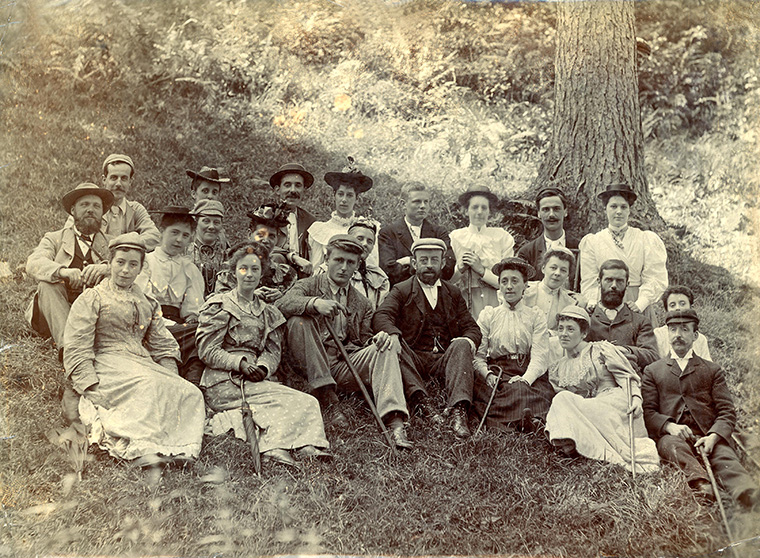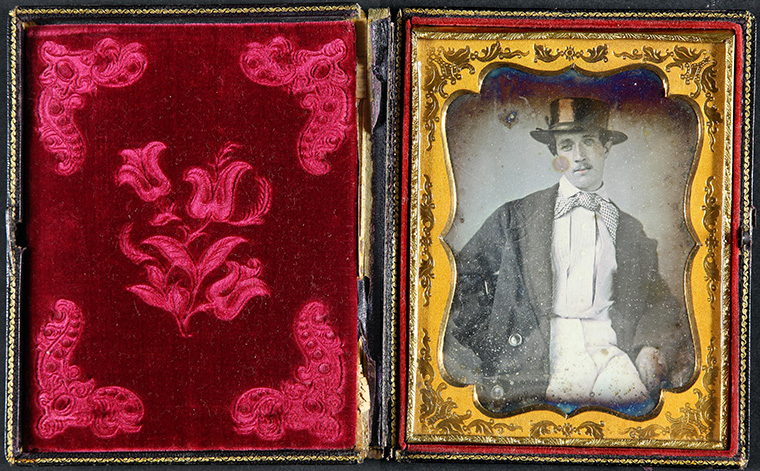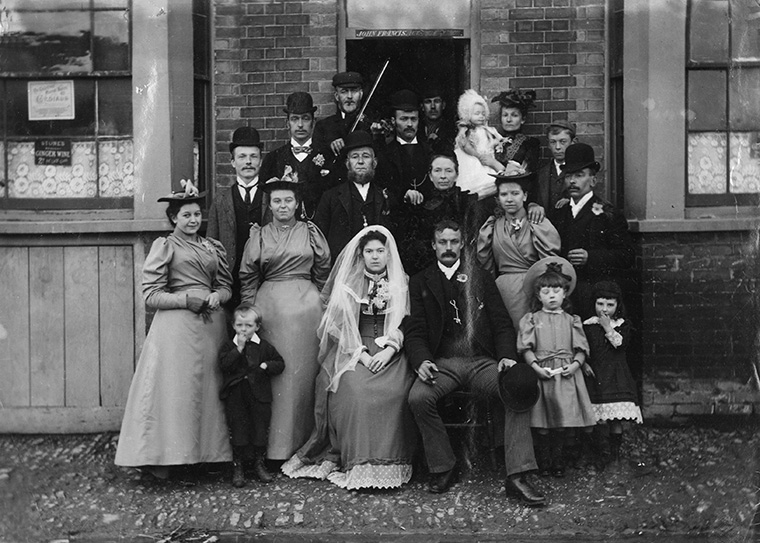When photographs are passed down through generations of families, sometimes the stories of the people in the images become fragmented or lost. If you find yourself with a collection of photographs that lack contextual information, there are a number of clues you can look out for.
The most effective way to date photographs is to combine historical analysis with knowledge of different photography techniques and materials through time. Here at The National Archives, we have teams who specialise in both areas and in this blog, Visual Collections Researcher Katherine Howells and Conservator of photographs and paper Ioannis Vasallos share their tips.
1. Check for written clues
It may seem obvious, but don’t forget to check the photograph carefully for any written marks which might point towards its age. Does the photographer’s studio name appear on either side of the photograph? If so, you may be able to date it to the period when the photographer was active.
You can also look out for handwritten notes on the back of the photograph such as names, events or locations. Some detective work might be required, but even a couple of words such as ‘Ann’s birthday’ or ‘Village fair’ can be immensely helpful!
2. Analyse the fashion and hairstyles
If your photograph depicts people, look at what they are wearing, as fashion can be a very useful indicator of when it was taken. Look carefully at any young women as women’s fashion developed faster than men’s and younger women tended to be more likely to wear more contemporary styles.
Look at the length and shape of skirts in particular. From a woman’s silhouette you may be able to determine whether she is wearing a bustle, what shape it is and also whether her gown has a train. Look also at sleeves – is there a puff at the shoulder? And hairstyles – consider the parting, fringe and accessories.
All of these clues will help you to determine the particular era of fashion being displayed. There are plenty of online resources on the history of fashion which can assist you in identifying the different elements.

3. Consider uniforms and medals
The presence of an individual in uniform can make the process of dating the photograph easier. This is the case for photographs taken in the 20th century, when uniforms become more standardised. However, for earlier photographs, uniforms can sometimes add to the mystery.
Again, online resources and books can help you to identify a particular uniform from similar photographs. If the photograph is clear enough, look for any medals the individual might be wearing. If you can identify a particular medal, you should be able to narrow down the time frame.
4. Look at the background and other objects
While some photographs might offer nothing in this regard (if your photograph depicts a group of people standing in a field you may not have much luck!), others might be filled with useful clues. If you can tell what town or village the photograph was taken in, see if you can identify buildings which you know were either built or demolished at particular times to narrow down a date range.
You can also look at the design of vehicles and their number plates, which may indicate the period in which a car or motorbike was produced. Advertisements and shop fronts are also useful as it can be fairly easy to ascertain when a certain product was launched and discontinued. These seemingly small details may provide a vital clue that draws your research together!
5. Don’t forget to ask
If you have living family members with a possible connection to the photograph, don’t forget to ask for their input. Sitting down with somebody and giving them time to reminisce over a photograph may be the most fruitful thing you can do.
Ask them if they recognise faces, fashions or locations depicted in the photograph. This is when a key piece of information might pop out of their memory which could solve the puzzle.
6. Look at the format
As photography developed in the 19th and 20th centuries, different kinds of formats rose and fell in popularity. Therefore identifying the type of format can help you to narrow down when the photograph was taken.
First look at how the image is surrounded and housed. If it is in a protective case, this may suggest it is a daguerreotype or ambrotype, and so was probably taken before the 1880s. If it is mounted on a thick card, it could be a carte de visite or cabinet card which date from the 1850s and 1914.
If there is a pair of photographs mounted next to each other on a card, then it is most probably a stereoscopic photograph dated between the 1860s and 1930s. If it looks like a postcard, it is more likely to have been taken after 1900.

7. Check the support of the photograph
Throughout history, a great variety of materials have been used to print or lay the image of a photograph on. Identifying these materials can be extremely helpful in ascertaining the process and therefore narrowing down the date range.
Metal was used on very early processes like daguerreotypes or tintypes. Daguerreotypes are one of the first photographic processes invented in 1839 and were common until the 1860s. They are made on a silver-plated copper support and have a distinct, highly reflective mirror-like surface. Tintypes, made on a thin tin sheet, were introduced much later than the daguerreotypes (1856) and were common up until 1920s.
Glass is more common than metal. Glass lantern slides were introduced as early as the 1850s and were used through to the middle of the 20th century. Ambrotypes, housed in a case like daguerreotypes, were common from 1854 until the 1860s. The glass support gives a 3-D appearance to the image but is not highly reflective like in daguerreotypes. Early negatives were also made on glass between 1880s and 1925.
Paper is the most common material used to print the image of a photograph on, and has been used throughout the history of the medium, from 1839 until today.
Plastic has been mainly used for negatives since the late 19th century. Colour slides were introduced in the 1930s and are commonly found in family photographs.
There are detailed guides available online to help you identify the different photographic processes.
8. Observe the colour tone of the image
Although colour tone can be a misleading tool with which to date photographs, if combined with other tips, it can be a helpful aid, especially for photographs on paper support.
In general, warm image tones are found on photographs made from the 1860s until the 1910s. Neutral black and white image tones are more commonly encountered on photographs made from the late 1890s until the present day. A distinctive example is cyanotypes, commonly made from 1842 until the 1950s, which can be distinguished by their deep blue colour.

9. Examine the surface characteristics
Using a light source to look at a photograph from many different angles may reveal useful information about the way it was made. The very first photographs on paper, salted paper prints (1840-1855), do not have a reflective surface because they do not have an extra layer on top of the paper.
With the introduction of albumen (egg white) in 1860 as a medium applied on the paper support to carry the image, the surface of photographs became glossier. After the 1880s, additional layers, such as gelatine or collodion, completely covered the fibrous surface of the paper, making the surface of the photograph even glossier.
Photographs with matt surface came back into fashion in late 1890s, but this was achieved by creating a bespoke rough surface pattern, rather than exposing the surface of the paper. Hand colouring, which is used in many 19th century photographs, can also easily be spotted, especially if a light source is used on a 180 degree angle.
If you have a magnifying glass or a small loupe, you can examine the surface of your photographs in more detail.
10. Look for signs of deterioration
Image deterioration such as fading and yellowing is common on the majority of 19th and 20th century photographs, especially those made on paper. Salted paper prints (1840-1855) often display fading on lighter areas of the image. Yellowing is frequently encountered on albumen prints (1860-1890s), especially around the edges.
Another very common form of deterioration is silver mirroring, a reflective blue-tainted shine formed on the dark areas of the image. Although this can be present in all photographic processes, it can be more extensive on those made during the 1900s.
Finally, if you have a cased photograph, look for any green-brown marks, a sign of deterioration found only on daguerreotypes (1839-1860), also known as tarnishing.
Put it all together
In order to get a clearer idea of when a photograph was taken, it’s likely you’ll need to carefully consider many of the points above. While you may never reach a definitive date, piecing together the clues will enable you to find an estimated date range. It may take perseverance, but it will be worth it!
Online resources
Identifying photographic processes: http://www.graphicsatlas.org/
Victoria & Albert Museum guide to photographic processes: https://www.vam.ac.uk/articles/photographic-processes
The Photographic Materials Group of the Institute of Conservation: https://icon.org.uk/groups/photographic-materials
Forces War Records advice on identifying military photographs: https://www.forces-war-records.co.uk/blog/2018/06/21/military-photograph
Science and Media Museum guide to photographic processes and formats: https://blog.scienceandmediamuseum.org.uk/tag/date-a-photograph/
Findmypast guide to historical fashion: https://www.findmypast.co.uk/blog/help/family-photos-what-are-they-wearing
Royal Photographic Society list of finding aids for 19th-century photographers: https://rps.org/resources/researching-historical-photographers/
We found a selection of photos of our family for sale on ebay when the photographic studio stock was cleared out – most from 1900s when they had all sat for photos, but some of the children as babies and my grandmother as a 6 year old, an 14 year old, and then as a young woman; she died age 83 in 1960.
I have a polyfoto page of photographs of my mother when very young – late 1930s or 1940s I think but no date on it just a code – PG1039. I have no idea if its possible to date this (she died recently) but she is very young in the photos so suspect taken when she went to London to nurse in 1939ish or wartime. Suggestions gratefully received!
Where can I find info on a photograph of a rural teenage girl I’m guessing was taken about after 1900. Most info I find on period dress rarely covers rural female clothing. This girl is wearing a plain colored smock with elbow length sleeves ending with ruffles. It appears to be homemade. She’s wearing this with a white detachable crocheted collar and black tights with tied, black leather shoes, possibly with a small heel. Her hair is ear length, neatly parted and held back by a very large barrette. In the background there are rural buildings and some type of braced wire fence (barbed?) for livestock. Does not appear to be a professional photo. It is framed and the paper is discoloring and appears to be deteriorating. It was found in my deceased sister’s things after she passed away. There is a family resemblance and all of my grandparents were raised on Iowa farms so if I can narrow the time period, it would greatly help in identifying this individual. I would be grateful for any resources you could share that I could access to help me determine a more definite time frame to unravel her identity. Thank you.
Les Newall’s book, “A History of Vehicle Registration in the United Kingdom” is helpful in dating pre-1964 number plates.
I have a few photos of family members one being my 2nd great grandfather he was born 1843 ire. He has on a white shirt high calor open with a small gap in middle. Sleeve rolled half way up..
Behind him a women may be my 2nd great grandmother I can not tell what kind of dress it’s dark goes to the floor open like a v neck with what looks like two buttons . lapels are wide covering INS de the V is what looks like a white blouse ..with high calor .with white ruffles cuff out from what sleeves.
Another man About 30 or 31 born 1864 he has my on a dark suit shirt again has high calor ( sorry for spelling ) he has one of those fancy round straw Flat top hats with a black rim around the top part of hat .
There are two other women standing
With white dresses to the ground slim fit look like they are just n the mid to late 20s ..the first man I mentioned I know is my 2nd great grandfather I need date of pi in order to figure out if the last man is my Great grand father who died in Jan 1901
The pictures is in a field and a snack in back ground may be a chicken coup and it may be in Waterbury Connecticut..
I have two photographs of two ladies. I would like help with dating the images
I have 200+ portrait photos of ladies from 1890 to 1970, I was successful on my first investigation as I was lucky it had a name on the back, but no date…..fashion big clues…. coupled with searching on Free BMD website for estimated date of birth , name look up , found marriage certificate then death etc….with that I found her resting place and was able to put a face to that weathered headstone, memorial will be left asap….
now….next case…